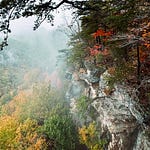Well, here we are: it’s Monday in October, and after last week’s full moon, we enter a story today that’s equal parts darkness and light. It’s an absolute banger as I hear tell on the ‘gram, so I won’t waffle on further. Let’s just jump right into it.
I don’t even know where to start with this. It’s just too much.
Just so we’re not here all day, I’ll take two scenes that seem to sit with me more than others and try to unpack them a bit. I’d love to hear which ones were the most vivid for you.
The first is the dinner with Baba Yaga.
She’s often referred to as a trickster figure—the Old Crone, reminiscent of the Transgressive Feminine made manifest. Or maybe the Wild Nurturer if you’re more into naturalist interpretations.
I would politely suggest we avoid framing fairy story characters in such terms, or even approaching the stories in this way. I don’t think it’s the right way to go. These kinds of stories are short indeed, but they aren’t “short stories,” if you get my drift. They aren’t entertainments to psychoanalyze or apply lit theory scalpels to. Archetypes discard context, which creates a myopia that like any bad habit can be very hard to get out of. Plus, it’s not really the salient stuff; it’d be like weighing the merits of Fahrenheit 451 by arguing over the lignin content of the pages. Yes, you can do that; no, it’s not generally helpful.
Anyway, let’s get back to the final night in the hut. It reminds me of “My Dinner with André” if Ingmar Bergman had directed it instead.
During the dinner, Baba Yaga reveals a sideways style of speech that can be hard to navigate. She’s flabbergasted that Vasilisa never had the courtesy to sit with her, but had the girl ever presumed to do so without asking, she’d have surely been eaten.
Questions are better, Baba Yaga tells her. But some answers can hurt. And others can age you.
How right she is. The Old Lady in the Forest is often overwhelming. It’s hard to keep from getting lost in her labyrinth of a hut, she may trick you at every turn but if you stick around long enough to be asked to dinner, she’s got some wisdom to share. Maybe she has more people as dinner than has them for dinner because it’s hard for her to find creditable company.
At the end of the dinner, again we see Baba Yaga’s mercurial nature when she throws Vasilisa out of her hut. She kicks her out, yes, but insists on the girl taking a little gift with her first—the very thing Vasilisa was sent to bring back, so she claimed. I see her saying this when she’s bending over to put a little elbow grease into attaching the skull to the stick—hiding her wide grin. Give them this, dearie, it’s what they said they wanted.
The second scene I wanted to mention is Vasilisa’s second visit—this time staying with the kindly old grandmother in a far-away village. After all that she had been through, all she wanted to do was to spin. It was spinning that her wicked stepmother forced her to do, yet for her, the craft wasn’t tainted by the bad memories. She still saw value in it. As Bruce Dickenson is fond of saying, “nothing in youth is ever wasted,” is it? Quite the healed and wizened woman is this new Vasilisa.
Bring up the hero’s journey today, and anyone who ever sat a film studies or creative writing lecture is going to bring up Joseph Campbell. Yes, that sort of thing can be a good tool for storytelling, but that’s not where these particular stories came from. That’s the wrong hero’s journey.
There’s a far older one that was more ritual than entertainment. Music, myth and story were the drivers, and the intent was to take the participant on their own journey through the Otherworld. Through their traverses, they were the hero. They were the ones undergoing the change. It was a personal, inward journey, not an external framework for animators. Substack’s own Ted Gioia covers this brilliantly in Music to Raise the Dead.
I think part of the cliché about tortured artists comes from a misunderstanding about this process. You don’t have to be miserable to express yourself; David Lynch was always very adamant about that point. It’s just that coming out of isolation or some kind of ordeal can spark creative inspiration. They say of Wales’ Cadair Idris that if you spend a night on its summit, you’ll either wake up mad, or a poet.
There’s of course more to this story and then some. What about the doll? And what of the yarn she spun and turned into shirts? That’s where I hope to hear from you all. What did you take away from the story? What details do you sit with? What does your imagination keep going back to?
As always, thanks so much for listening, and please do tell me what you thought in the comments. It’s been great fun hearing everyone’s thoughts and ideas on the stories so far.












